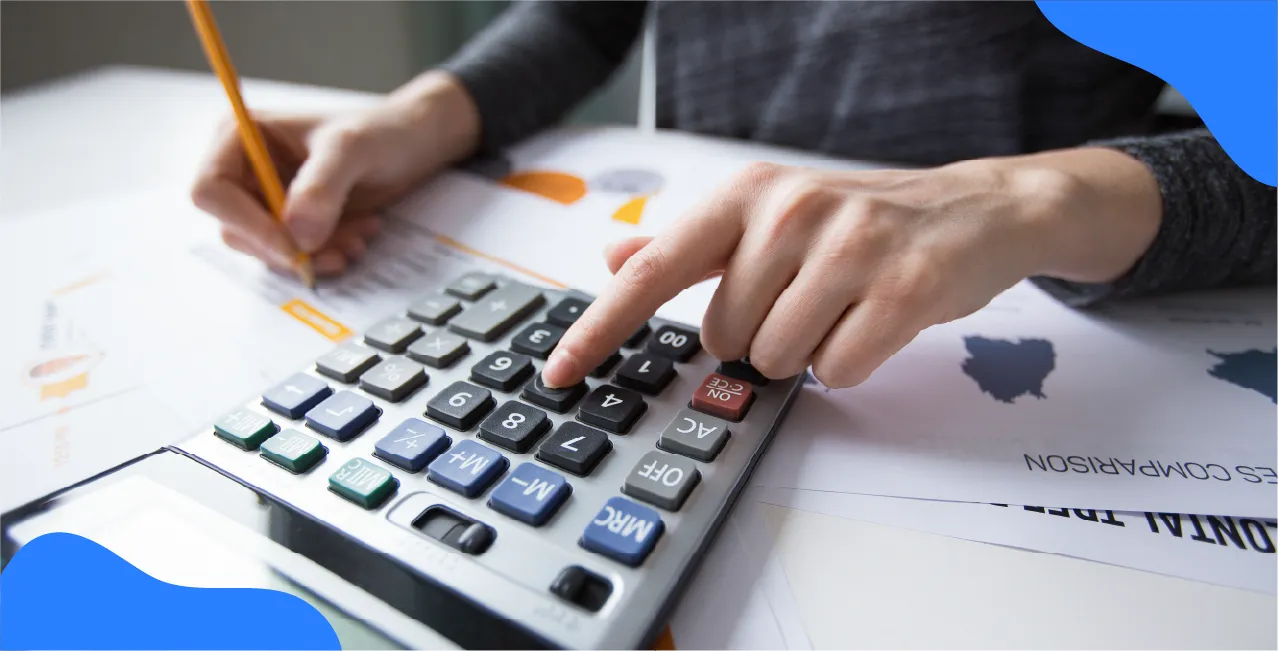
Author
LoansJagat Team
Read Time
6 Min
23 Jul 2025
What Is the Accounting Cycle? Step-by-Step Overview
The accounting cycle is a step-by-step process used to record, organise, and summarise financial transactions during a specific period.
It ends with financial statements and book closure, ensuring accuracy, consistency, and compliance for smart business decisions and legal reporting.
Isn’t it interesting how numbers can clearly show how a business is doing? Take the example of Ankit, who runs a small café in Jaipur.
Here’s what his April 2025 looked like:
- He earned ₹1,20,000 in sales.
- He spent ₹60,000 on groceries and coffee supplies.
- Paid ₹25,000 in staff salaries.
- Paid ₹10,000 in rent and other bills.
- Had an unpaid electricity bill of ₹5,000.
Now let’s do the math:
Total expenses = ₹60,000 + ₹25,000 + ₹10,000 + ₹5,000 = ₹1,00,000
Profit = ₹1,20,000 – ₹1,00,000 = ₹20,000
By following the accounting cycle, Ankit knew exactly how much he earned and spent. That’s how smart businesses stay in control.
This blog explains the accounting cycle, its steps, timing, importance, and the shift from manual to automated systems.
What Is The Accounting Cycle?
The accounting cycle tracks a business’s financial activities.
Read More – What is a Balance Sheet
Let’s understand it with the help of an example:
In April, Meera’s shop made ₹80,000 from sales and spent ₹45,000 on things like rent and supplies. She wrote down every money detail, updated her records, checked the totals, made changes where needed, and prepared reports that showed she earned ₹35,000 as profit.
After that, she closed her books for the month. This helped her keep things clear, correct, and ready for any checks.
What Are The 8 Steps Of The Accounting Cycle?
Let’s understand the 8 steps of the accounting cycle using a practical example. Let’s say GlowTech Pvt. Ltd., is a small electronics store. During March 2025, it had the following financial activities:
8 Steps of the Accounting Cycle
1. Identify the Transactions
Start by spotting all the money-related activities in your business, like sales, purchases, payments, or expenses.
Example: On March 1, GlowTech received ₹1,50,000 from the owner. On March 3, it bought electronics worth ₹60,000. These are important money transactions to note.
2. Record the Transactions
Write each transaction down in your journal (a daily logbook) as it happens. This keeps a time-based record of everything.
Example: GlowTech recorded the ₹1,50,000 capital received and the ₹60,000 inventory purchase in its journal to keep a proper order of daily activities.
3. Post to the Ledger
Move the journal entries into your ledger, where everything is sorted by category—like cash, rent, sales, etc.
Example: The ₹60,000 spent on electronics was posted in the "Inventory" and "Cash" ledgers to clearly show where money was spent.
4. Prepare an Unadjusted Trial Balance
List out all the ledger account balances and check if the total debits equal the total credits. If they match, you’re on the right track.
Example: GlowTech checked that debit totals (like cash and inventory) matched credit totals (like capital and sales). Everything added up correctly.
5. Review and Make Adjustments
Go through your accounts and see if any updates are needed, like recording unpaid bills or correcting errors.
Example: GlowTech remembered it had ₹15,000 in unpaid salaries. It noted this as an expense even though it hadn't been paid yet.
6. Record Adjusting Entries
Add those adjustments into your records to make sure everything is accurate—this step helps reflect the real financial picture.
Example: GlowTech added the ₹15,000 salary as a liability in its records to show the business owes money even if not yet paid.
7. Create Financial Statements
Use the updated numbers to prepare key reports like the income statement, balance sheet, and cash flow statement to see how your business is performing.
Example: GlowTech created a report showing ₹1,00,000 in sales, ₹70,000 in total expenses, and a profit of ₹30,000 for March.
8. Close the Books
Wrap up the period by clearing out income and expense accounts and transferring the final results (like profit or loss) to your capital or retained earnings.
Example: After March, GlowTech closed its revenue and expense accounts and moved the ₹30,000 profit to retained earnings for future use.
Also Read - What is an Income Statement?
Importance of the Accounting Cycle in Business:
The accounting cycle ensures accurate, consistent, and reliable financial records. It supports compliance with laws, helps prepare clear financial reports, improves decision-making, increases transparency, and saves time by creating a structured system for managing all financial activities in a business.
Let’s take the example of Priya, who runs a clothing boutique called PriyaWear in Delhi. In April 2025, she had the following financial activities:
Let’s walk through why the accounting cycle helped her:
1. Accurate Records: Priya recorded every transaction in her journal and posted them in her ledger. This avoided confusion or missed entries.
2. Adjustment Made: She added the ₹20,000 salary expense even though it wasn’t paid yet. This helped her see the real financial position.
3. Financial Reports: She prepared a trial balance and financial statements that showed:
- Total Expenses: ₹70,000 + ₹15,000 + ₹20,000 = ₹1,05,000
- Profit: ₹1,20,000 – ₹1,05,000 = ₹15,000
4. Compliance & Clarity – These reports helped her file taxes properly and also present accurate figures to a bank for a loan.
So, thanks to the accounting cycle, Priya wasn’t just managing money; she was building trust, planning growth, and making smart financial moves.
Manual vs. Automated Accounting Cycles:
A recent report by Pearson revealed that generative AI could automate 46% of accounting tasks in India by 2032, reshaping the traditional accounting landscape. Manual accounting means writing down transactions by hand or in Excel, which can lead to mistakes. Automated tools like Tally do the work faster and more accurately using software.
Let’s take Raj, a small bookstore owner in Bhopal, as an example. In June 2025, he manually calculated his expenses and profit:
- Sales: ₹2,00,000
- Purchases: ₹1,20,000
- Salaries: ₹30,000
- Rent: ₹10,000
- Utilities: ₹5,000
Profit: ₹35,000.
But due to a typo, he recorded utilities as ₹50,000, showing only ₹20,000 profit, an error that confused his tax filing.
After switching to automated accounting, his software flagged the mistake and corrected it, restoring his actual ₹35,000 profit.
Here’s a quick comparison:
While manual accounting may suit small setups, automated systems are ideal for growing businesses seeking efficiency, accuracy, and control.
What Is The Timing Of The Accounting Cycle?
The accounting cycle follows specific periods—monthly, quarterly, or yearly—to record, process, and close financial transactions.
It starts with the first transaction and ends with financial statements and book closure for that period.
Let’s understand with an example:
Ritu runs a small cafe in Jaipur. She follows a monthly accounting cycle to track income and expenses.
In April 2025:
- Sales: ₹3,00,000
- Purchases: ₹1,00,000
- Salaries: ₹50,000
- Rent: ₹20,000
- Utilities: ₹5,000
She records all these in her journal, posts them to the ledger, and prepares a trial balance:
Total Income: ₹3,00,000
Total Expenses: ₹1,75,000
Profit: ₹1,25,000
She then adds a ₹5,000 expense for wear and tear, finishes her monthly reports, closes the accounts, and checks everything one last time to make sure it's correct.
This cycle repeats each month, giving her a clear view of profits and helping her plan better.
Timing Table of Accounting Cycles:
Accounting cyc
les have very different time durations. Refer to the table below to observe the various account cycles tailored to different business needs.
Conclusion
The accounting cycle is a simple way to keep your business's money matters in order, from noting sales to closing your accounts. It helps you see what you earn and spend. At first, you might use pen and paper, but as your business grows, software makes it faster and easier. In the end, it helps your business grow the right way.
FAQs:
Q1: What is the accounting cycle in simple terms?
It’s a step-by-step process to record, adjust, and report all financial transactions in a business.
Q2: Why is the accounting cycle important for small businesses?
It ensures accurate records, supports smart decisions, and keeps your business compliant with financial regulations.
Q3: What are the main steps in the accounting cycle?
Identify, record, post, trial balance, adjustments, financial statements, and close the books.
Q4: When should a business switch from manual to automated accounting?
When transactions grow, accuracy, speed, and efficiency become harder to maintain manually.
Q5: How does accounting software improve the accounting cycle?
It automates entries, reduces errors, saves time, and gives real-time financial insights.
Other Related Pages | |||
About the Author

LoansJagat Team
‘Simplify Finance for Everyone.’ This is the common goal of our team, as we try to explain any topic with relatable examples. From personal to business finance, managing EMIs to becoming debt-free, we do extensive research on each and every parameter, so you don’t have to. Scroll up and have a look at what 15+ years of experience in the BFSI sector looks like.

Quick Apply Loan
Subscribe Now
Related Blog Post


